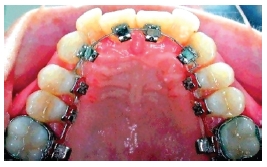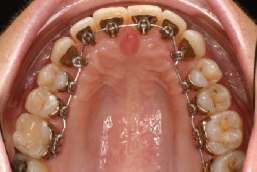Chapter 15
Fixed appliances – indirect bonding and lingual orthodontics
This chapter is an extension of the two previous ones that dealt with fixed appliances which were directly bonded onto the labial surface of the teeth.
However, attachments can also be bonded onto the teeth using an indirect method. This is a technique that is also frequently used when bonding attachments to the lingual surfaces.
LINGUAL ORTHODONTICS
The Lingual technique is becoming more widely used as patients are increasingly aware of the advantages and possibilities that it makes available.
Many clinicians are now practised in the technique and are able to offer it to their patients. This treatment is an alternative to conventional fixed appliances and are fixed to the labial aspect of their teeth (Figure 15.1).
Lingual orthodontics was initially pioneered in the 1970s in Japan, where it was intended as an alternative for patients who took part in martial arts, and in America, where it was seen as an aesthetic option.
The development was slow as the 1980s saw the introduction of aesthetic brackets and invisible aligners, which offered patients another, less visible, alternative to metal brackets.
Figure 15.1 Lingual appliance. (Reproduced with permission of Paul Ward, British Lingual Orthodontic Society.)

There has been a renewed interest in lingual orthodontics rather than aligners as an option due to:
- the high laboratory cost of aligners, especially if one gets lost or broken
- they need a high level of patient compliance
- the limited treatments they can provide
Advantages of lingual orthodontics
- of particular benefit to patients who play musical instruments by mouth, especially clarinets and saxophones
- good aesthetic effect especially for adults in occupations where appearance is very important
Disadvantages
- patients sometimes have difficulties with speech
- there can be trauma to edges of the tongue (ulceration)
WHAT MATERIALS ARE USED
Because of their position in the mouth, the pliers and hand instruments that are used to fit and adjust labial appliances would be of little use with lingual appliances. They need to have very fine edges which allow easy access to the brackets and give a less restricted view in the mouth. Impression materials are usually rubber based and models are cast in stone or a hard material.
Brackets
For ease of use, many lingual appliances use self-ligating brackets, but there are systems available which require ligatures or O-rings (Figure 15.2).
Many of these appliances are fitted using the indirect bonding technique but some, notably those which concentrate on the anterior segment only, use direct bonding.
Brackets tend to be smaller, and the bases curved to accommodate the lingual surface.
Wires
The main difference between labial and lingual arch wires is in the shape.
Figure 15.2 Lingual appliance with gold brackets. (Reproduced with permission of Paul Ward, British Lingual Orthodontic Society.)

Figure 15.3 Lingual appliance – note shape of arch wire. (Reproduced with permission of Paul Ward, British Lingual Orthodontic Society.)

Lingual arch wires (Figure 15.3) look rather like mushrooms as they have a rounded top, which fits around the anterior teeth and then a ‘bend’ inwards to accommodate the differing canine/premolar width before flaring to attach to the premolars and molars.
Wires come as upper and lower, and in the same metal as non lingual techniques.
Round wire sizes:
- 010′′
- 012′′
- 013′′
- 014′′
- 016′′
Square wire sizes:
- 0.016′′ × 0.016′′
- 0.017′′ × 0.017′′
Rectangular wire sizes:
- 016′′ × 022′′
- 017′′ × 017′′
- 017′′ × 025′′
come in:
- small
- medium
- large
PLIERS
- ligature cutters come in 40◦, 50◦ or 60◦ of angulation and have reversed or regular curves depending on where they are to be used
- Mathieu pliers are curved
- Weingarts pliers have a 60◦ angle
- bracket removing pliers and cinch back pliers are of a special design
- distal end cutters must be safety hold
When a patient requires extractions as part of their treatment plan it is usual to have this done a week prior to the fitting of the lingual appliances. When the patient is having a lingual appliance fitted using the indirect technique, the appliance is fitted before the extractions are carried out. The arch wire is removed to allow the dentist access for the extractions. This is to prevent the teeth adjacent to the extraction sites from moving between the time of extraction and fitting of the appliance.
ORAL HYGIENE
Oral hygiene techniques when wearing lingual appliance have many similarities to those used when wearing labial appliances and include:
- a tooth brush
- an interspace (tufted spiral) brush
- wax
- floss
- disclosing tablets
- mouthwash
Stay updated, free dental videos. Join our Telegram channel

VIDEdental - Online dental courses


